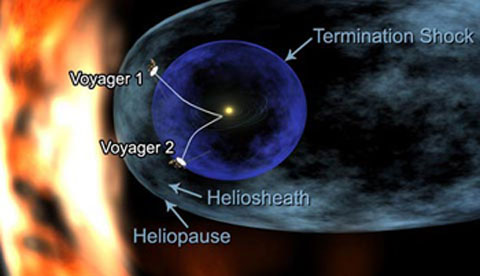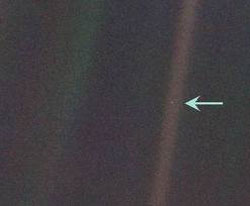Voyager spacecraft approaching interstellar space—35 years after launch
By Bryan Dyne
28 September 2012
Thirty-five years have passed since the launch of the two Voyager spacecraft. Each pioneered the study of the outer Solar System, with Voyager 2 the only space probe to visit Uranus (1986) and Neptune (1989). Voyager 1 is currently the furthest and fastest spacecraft still operational and will soon escape the Solar System and enter interstellar space.
Both spacecraft have long exceeded their original mission expectations. Voyager 1 and Voyager 2 were launched in 1977, on September 5 and August 20 respectively, with the goal of performing the first significant scientific studies of the gas giants, Jupiter, Saturn, Uranus and Neptune. After the 1989 Voyager 2 flyby of Uranus, the decision was made to keep both spacecraft operational and use the instruments aboard to learn what they could beyond the planets, thus beginning the Voyager Interstellar Mission.
The science done with both spacecraft has always been groundbreaking. Each held an identical suite of tools: instruments to image objects in the ultraviolet, visible and infrared wavelengths, the ability to analyze the charged particles and magnetic fields around each planet, to study cosmic rays in the sea of particles between the planets and to record the composition and physical properties of the atmospheres of the outer planets.
Active volcanoes of Jupiter’s moon Io and the intricacies of Saturn’s rings are two of the most prominent discoveries of the Voyager probes. Voyager 1 was the first to look at the atmospheric structures of Saturn’s moon Titan, while Voyager 2 is still the only spacecraft to study Uranus and Neptune up close.
The most recent data coming from both Voyager spacecraft, particularly Voyager 1 as it is further out, comes from what constitutes the edge of the Solar System.
Particles emanate from the Sun at an average rate of 1.4 billion kilograms of material every second. The particles, known as the solar wind, travel out along the magnetic field lines generated by the Sun until they begin interacting with the gas of the Milky Way galaxy. When the solar wind hits this interstellar medium, the particles begin to slow down, an area called the heliosheath.
Starting in 2010, Voyager 1 began detecting particles with zero velocity relative to the Sun, an area since dubbed the stagnation zone.
 The heliosheath of the solar system
The heliosheath of the solar systemThe Voyagers have also detected, starting in 2007, 100 million mile-wide bubbles created from the interaction of solar wind and the interstellar medium. They are caused by the disorientation of the solar magnetic field near the outer edge of the heliosheath, caused in part by the solar wind slowing down. As the Voyagers travel onward, they will continue to shed more light on how the bubbles are made.
Most recently, Voyager 1 has detected more significant changes in its environment. The intensity of the magnetic field lines from the Sun have doubled and the cosmic ray count from the galaxy has increased 100-fold. From this data, NASA predicts that by 2014 Voyager 1 will detect a sharp drop of the charged particles around it and a total change in orientation of the magnetic fields; at this moment, Voyager 1 will become humanity’s first interstellar spacecraft.
There is a cultural significance to the Voyager missions as well. Each carries a gold-plated copper phonograph record, with an aluminum and uranium-238 cover. The contents consist of the sound of “hello” in 55 languages, as well as greetings to any alien race that may encounter the craft. The contents also consist of music, including Beethoven, Guan Pinghu, Mozart, Stravinsky, Blind Willie Johnson, Chuck Berry and Kesarbai Kerkar, a recording of human brainwaves, and a series of images of Earth.
The records on the Voyager craft are similar to those placed on Pioneer 10 and 11, an attempt to send something understandable to any alien intelligence that might find the craft. The plate also includes a map of the Sun in relation to fourteen nearby pulsars, to give the location of our Solar System within the Milky Way galaxy.
The distance and capabilities of the Voyager craft also inspired the picture of Earth that Carl Sagan popularized as the “Pale Blue Dot.” It was taken by Voyager 1 in 1990 after the completion of its primary mission, when it was ordered to turn around and take an image of the Earth from 6 billion kilometers away. The Earth is a single pixel in the image, or as Sagan put it, “a mote of dust suspended in a sunbeam.”
 "The Pale Blue Dot"—planet Earth
"The Pale Blue Dot"—planet EarthVoyager 1 and 2 were launched at the end of the NASA’s major drive to space in the 1960s and 70s, resulting from a geopolitical need to beat the Soviet Union in all areas concerning space exploration. They were the result of a scaled back “Grand Tour” program. The original concept would have sent several pairs of probes to the outer planets, including missions consisting of Jupiter-Saturn-Pluto and Jupiter-Uranus-Neptune flybys. The final mission was instead two missions: Voyager 1, which went to Jupiter and Saturn, and Voyager 2, which went to Jupiter, Saturn, Uranus, and Neptune.
Today, no such vision exists within NASA. Voyager was the last gasp of the space race; technological feats spurred on by US competition with the USSR. Without a rival superpower in the world arena, and with its own resources severely depleted by long-term economic decline, the American space program has been massively scaled back.
This is not to dismiss the achievements that still take place—including the ongoing work of the Hubble Space Telescope, the Cassini mission to Saturn, and recent landing of Curiousity on Mars—but to emphasize that the very human endeavor of discovery will remain stunted for as long as it is subordinated to private profit.





Follow the WSWS